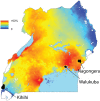Mind the gap: house structure and the risk of malaria in Uganda
- PMID: 25635688
- PMCID: PMC4311957
- DOI: 10.1371/journal.pone.0117396
Mind the gap: house structure and the risk of malaria in Uganda
Abstract
Background: Good house construction may reduce the risk of malaria by limiting the entry of mosquito vectors. We assessed how house design may affect mosquito house entry and malaria risk in Uganda.
Methods: 100 households were enrolled in each of three sub-counties: Walukuba, Jinja district; Kihihi, Kanungu district; and Nagongera, Tororo district. CDC light trap collections of mosquitoes were done monthly in all homes. All children aged six months to ten years (n = 878) were followed prospectively for a total of 24 months to measure parasite prevalence every three months and malaria incidence. Homes were classified as modern (cement, wood or metal walls; and tiled or metal roof; and closed eaves) or traditional (all other homes).
Results: A total of 113,618 female Anopheles were collected over 6,765 nights. 6,816 routine blood smears were taken of which 1,061 (15.6%) were malaria parasite positive. 2,582 episodes of uncomplicated malaria were diagnosed after 1,569 person years of follow-up, giving an overall incidence of 1.6 episodes per person year at risk. The human biting rate was lower in modern homes than in traditional homes (adjusted incidence rate ratio (IRR) 0.48, 95% confidence interval (CI) 0.37-0.64, p<0.001). The odds of malaria infection were lower in modern homes across all the sub-counties (adjusted odds ratio 0.44, 95%CI 0.30-0.65, p<0.001), while malaria incidence was lower in modern homes in Kihihi (adjusted IRR 0.61, 95%CI 0.40-0.91, p = 0.02) but not in Walukuba or Nagongera.
Conclusions: House design is likely to explain some of the heterogeneity of malaria transmission in Uganda and represents a promising target for future interventions, even in highly endemic areas.
Conflict of interest statement
Figures




References
-
- Habitat UN (2010) State of African Cities 2010: Governance, inequalities and urban land markets Nairobi: UN Habitat; 280 p. 10.2174/157340310793566145 - DOI
Publication types
MeSH terms
Grants and funding
LinkOut - more resources
Full Text Sources
Other Literature Sources
Medical
Molecular Biology Databases
Miscellaneous

